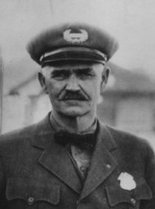This house was the site of the most notorious crime in Medford's history, the murder of Constable George Prescott in 1933.
Llewellyn Banks, a wealthy orchardist, purchased this house in 1929. Banks acquired a number of orchard tracts in the Rogue Valley and ultimately built his own packing plant. He gained the loyalty of many small orchardists by pricing his packing services below the established rates of other packing houses. Banks was noted as flamboyant, a man who owned two Cadillacs and has his new home carpeted with Oriental rugs.
In 1929 Banks also purchased the Medford Daily News. Politically, Banks could be described as a Populist and he used his newspaper as a vehicle to publish commentaries he wrote on national and local events that impacted Populist-leaning citizens. His articles tended to be anti-government, anti-corporate, described by some as semi-fascist. Banks gained a great deal of popularity among people who shared his views and was described as a charismatic, almost "hynpotic" public speaker.
Banks entered the 1930 contest for U.S. Senator, running as an independent. He was soundly defeated but won 40% of the vote in Jackson County, leading him to seek to build on his local political influence. Banks and fellow publisher and ally Earl Fehl stirred the pot of discontent in depression-era Jackson County, supporting candidates to defeat incumbent officials who Banks characterized as "the gang."
By 1932, political tensions reached a boiling point, leading to events known as "The Jackson County Rebellion." The elections for Jackson County Judge and County Sheriff became focal points. When the Banks-backed candidate Gordon Schermerhorn defeated the incumbent Sheriff Jennings in the election, Jennings called for a recount. Sheriff-elect Schermerhorn went into hiding and the tone of Banks's news articles grew more violent. Fehl, who won election as the County Judge, assumed office and immediately issued warrants for the arrest of outgoing county commissioners who Banks-Fehl had previously opposed. Armed "vigilance committees" roamed the county under Banks's direction, preparing to seize control. Banks and Fehl organized the "Good Government Congress" (GGC) and while Fehl, as an elected judge, kept his distance, Banks was heavily involved in the organization, serving as honorary President. The GGC was encouraged by Banks and Fehl to "rise up" and take control of the government.
On February 20, 1933, a visiting Circuit Court Judge from Lane County was brought in to supervise the election recount request made by Sheriff Jennings. The night before the proposed recount was to occur, the ballots were stolen. The Oregon State Police investigation the followed obtained testimony from two county jailers who confessed to the crime; their confession implicated Judge Fehl as orchestrating the theft. Judge Fehl, the mayor of Rogue River, the foreman of the Jackson County Shops and several members of the GGC were indicted for the theft. The missing ballots were never recovered as they were divided, taken to various locations around the county, and either burned or tossed into the Rogue River.
When Judge Fehl posted bail, he resumed his office and ordered the release of most others who were implicated, most of whom then left the county. Banks was not directly linked to the ballot theft, but falling prices and poor business choices eroded nearly all of Banks's fortune, increasing the pressure on him. He lost control of the newspaper and turned to one final rally of the GGC, using it as an opportunity to lash out, threatening to political opponents that "I will take the field in revolution against you people."
Banks went into hiding in this house and on March 16th, Medford Constable George Prescott and Oregon State Police detective James O'Brien were sent to the Banks house with a warrant for his arrest. Banks had previously stated he would kill any officer who attempted to arrest him. According to the National Register of Historic Places Nomination Form:
"At approximately 10:15 in the morning, Prescott and [Detective] O'Brien ascended the steps of Banks' porch to serve the warrant. Two other officers covered the rear exit, by the garage, to prevent any
attempt at escape. O'Brien knocked on the front door and soon Edith Banks (Llewellyn's wife) opened it slightly, limited by the length of burglar chain. Prescott stated "I am sorry Mrs. Banks, but I have a bench warrant for your husband." Mrs. Banks attempted to shut the door but Prescott stopped it with his foot, adding "Just a minute, I will give you that warrant and let you read it...." As Prescott reached into his pocket to get the papers, Llewellyn Banks appeared over his wife's shoulder. As Mrs. Banks stepped out of the way, he stuck a hunting rifle through the narrow opening, leveled it at Officer Prescott, and shot him point blank in the chest. Prescott fell back into O'Brien's arms and the two men tumbled to the floor of the porch. The sixty-three year old Prescott died almost instantly. Detective O'Brien scampered from the porch and wrote "10:20, Officer Prescott killed...Banks shot with rifle..." in his notebook, to provide evidence should he himself be fired upon. Running across the street to an apartment building, O'Brien called for reinforcements. As police cars streamed into the area and began to cordon off the street for a possible siege, Mrs. Banks called Medford Police Headquarters and stated her husband's willingness to surrender peaceably. State Police Captain Lee Bown and Deputy Sheriff Phil Lowd, a former Banks-supporter, arrived and escorted the suspect to a jail cell in Josephine County, outside the jurisdiction of Jackson County's renegade Judge Fehl."
Following the murder of Constable Prescott, who was a much beloved public servant, support for the Good Government Congress evaporated. Bank and his wife were both charged in the murder of Constable Prescott and on the charge of "criminal syndicalism". The charges against Mrs. Banks were dropped but following the investigation and trial (held in Lane County), Llewellyn Banks was found guilty and sentenced to life in prison. He died at the Oregon State Penitentiary in Salem in 1945 at the age of 73.
Constable Prescott has a monument in the city park; an informational marker near his grave at Eastwood IOOF Cemetery notes the events that took his life. Medford also created Prescott Park on nearby Roxy Ann Peak in honor of Prescott, who had long supported creation of a park at that location.
This crime is chronicled in the book "Murdered In The Line of Duty: Constable George Prescott," by Margaret Laplante.

Llewellyn Banks
(1870-1945) |

George Prescott
(1871-1933) |